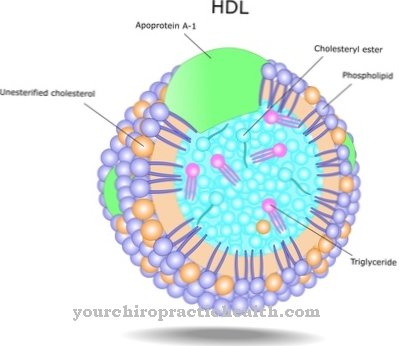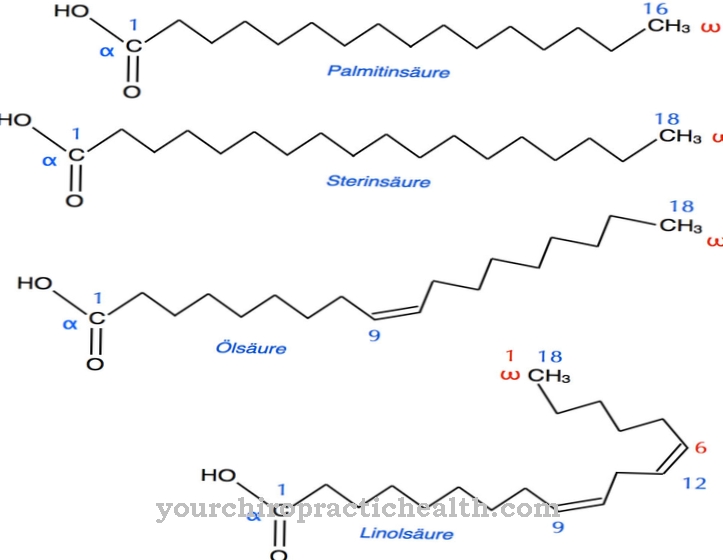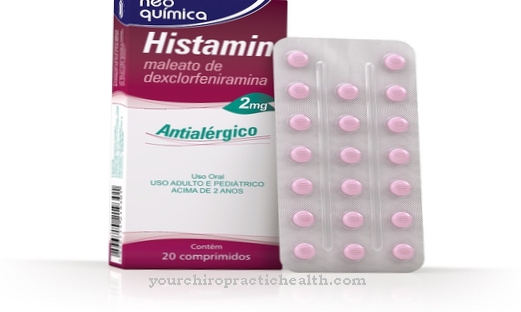histamine is an organic nitrogen compound involved in local immune responses in the organism, which regulates physiological functions in the intestine and acts as a neurotransmitter. In response to foreign pathogens and allergenic substances, histamine is produced by basophils and mast cells in order to intervene in inflammatory processes.
What is histamine?
histamine is a basic amine that is stored in mast cells and basophils and bound by ionic forces. The interaction between a triggering substance and the antibody immunoglobulin (IgE) on the surface of mast cells leads to the degranulation of these cells and the release of messenger substances such as histamine.
This acts on the receptors in the organism in order to induce necessary reactions such as the stimulation of gastric secretion, muscle contractions or vasodilation. Around 1% of the European population suffers from histamine intolerance to histamine ingested from food.
Medical & health functions, tasks & meanings
The nitrogen compound histamine is found in almost all of the body's tissue, but is concentrated in the lungs, skin and gastrointestinal tract.
It is produced and stored in the Golgi apparatus by mast cells and basophils through the decarboxylation of histidine by what is known as histidine decarboxylase. Histamine can be released immediately in inflammatory or allergic reactions and acts by binding to receptors on the target cells. Here, histamine causes intracellular events that lead to different effects in the different cell types. The stimulation of H1 receptors in human bronchial muscle cells increases local muscle contraction.
If the H2 receptors in the acid-producing cells of the stomach and heart are stimulated by histamine, the production of digestive enzymes and gastric acid as well as the atrial frequency of the heart increase to support protein and fat digestion. If the H3 receptors in the nerve tissue are activated, the release of neurotransmitters is throttled, which has an impact on sleep or sexuality, for example. It also stimulates the production of melatonin in the pineal gland, which is necessary for fat metabolism.
As a messenger substance, histamine is involved in the immediate hypersensitivity reaction and has an influence on leukocyte function.By binding to H4 receptors, it also has an influence on complex processes such as the inhibition of lectin- or antigen-induced growths of T cells, the release of lymphokines from T cells or the induction of cytotoxic T cells. If these processes are blocked by so-called antagonists, anti-inflammatory actions stimulated by histamine can reduce the hypersensitivity of the antibodies.
The effect of histamine on the blood vessels and the skin, however, inhibits the immune reactions when stimulated continuously and leads to the opposite effects, which is why antihistamines are used.
Illnesses, ailments & disorders
By histamine Stimulated vascular permeability causes fluid to flow from the capillaries into the tissue to prevent an allergic reaction. A triple reaction is typical for the effect of histamine on direct external irritation (e.g. as a result of an insect bite):
Reddening of the puncture site, reddening of the surrounding area (wheal formation) with itching and swelling of the affected area. If allergens encounter immunoglobulin in the mast cells in the nasal mucosa, they occur as histamine-associated reactions in addition to watery eyes, sneezing as a result of sensory neuronal stimulation, hypersecretion of glandular tissue and swelling of the nasal mucosa as a result of vascular congestion and increased permeability of the capillaries.
The immediate hypersensitivity to histamine, classified as type 1, is the result of a misdirected release of histamine as a result of the ingress of harmless substances such as grass pollen or certain foods.
The contraction of the muscles of the ileum, bronchi and bronchioles as well as the uterus stimulated by histamine can lead to increased peristalsis with food allergies. When examining asthmatics, it was found that histamine increases airway muscle tone and promotes mucosal edema and glandular secretions, which can narrow the airways and restrict airflow.
Histamine deficiency can lead the body to become dependent on carbohydrates, which are used to synthesize cholesterol. At the same time, histamine deficiency leads to lower melatonin levels and lowers fat metabolism in the brain, which increases physical stress. Studies show that a histamine deficiency lowers the folic acid level. Often times, patients with multiple sclerosis suffer from a lack of histamine, so various histamine replacement therapies have been developed.

























.jpg)


